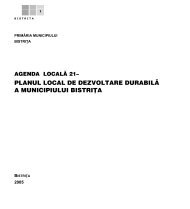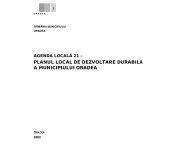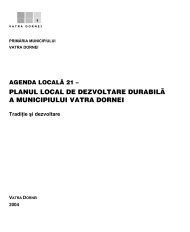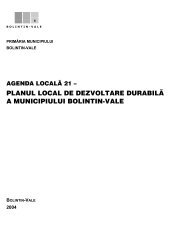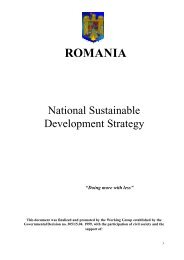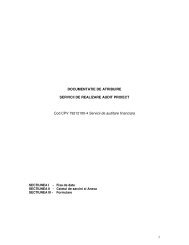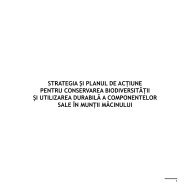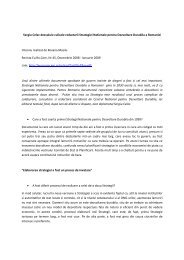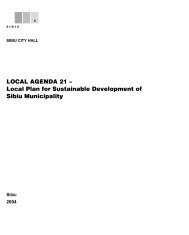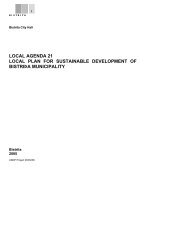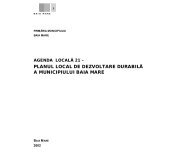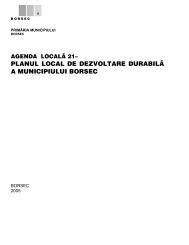LOCAL AGENDA 21 â LOCAL PLAN FOR SUSTAINABLE ...
LOCAL AGENDA 21 â LOCAL PLAN FOR SUSTAINABLE ...
LOCAL AGENDA 21 â LOCAL PLAN FOR SUSTAINABLE ...
You also want an ePaper? Increase the reach of your titles
YUMPU automatically turns print PDFs into web optimized ePapers that Google loves.
12MUNICIPALITYGiurgiu lies in a region heavily influenced by largecurrents of air with high variations of frequency,duration and intensity. As such, the cold and strongwind known as “Crivăţul” reaches the area from thenortheast during wintertime and brings frosty weatherand snow storms. “Austrul,” the dry wind coming fromthe south or southwest, is an almost permanentpresence all year and favours freezing temperatures inthe winter and drought in the summer. The humid wind“Băltăreţul,” specific to the Danube riverside bringswarm and thick rains from the southeast to north-westduring autumn and spring mostly. The eastern wind of“Suhoveiul” is specific to the height of the summer andcauses drought, soil erosion and sandstorms.The Danube Valley helps redirect much of the windgoing towards Giurgiu and therefore has a mitigatingeffect for the local microclimate. In the valley though,currents of cold air can accumulate and stabilise, thusfavouring the phenomenon of thermal inversion.I.1.4. NATURAL RESOURCESI.1.4.1. WaterThe Danube borders the administrative territory of themunicipality on the southeast for 7.3 km. The averageflow of the river streams is approximately 5,600m 3 /secand can exceed 10,000m 3 /sec during springtime whensnow starts melting.At present, Cama and Saint George water channelsrun into the mouth of the river, close to the municipalbuilt-in areas. Smârda and Ara branches are alsotributary to the Danube and flow downstream fromGiurgiu. Another branch of the river, Veriga, wasinitially systematised in 1905 to allow constructionworks for the harbour at Ostrovul Ramadan. Decadeslater, in the 1980s, the Chemical Complex waserected in the area and three still waters were all thatwas left of the former stream. Other natural ponds arelocated at Ostrovul Cioroiu (Lake Neamţului), MocanuIslet (Long Lake and Big Lake), west of Saint Georgechannel, near the mouth of the Danube, and west ofSmârda branch (Lake Ciobănaşul).Still waters stretch over 423 ha, which represents8.54% of the total administrative territory.I.1.4.2. LandLocal climate, biological and geomorphologic factors,and time have influenced the formation and evolutionof municipal lands. Rather unstructured alluvial soilsare prevalent in the region. The land has high humidityfrom contact with the underground water table and isprone to the formation of swamps.I.1.4.3. Flora and FaunaGiurgiu lies in an area where the forest steppe and themeadow meet. North of the Danube meadows, oakforests and groves and other leafy forests overlap withvarious species of shrubs. Human activities causedthe shrinkage of steppe grassland, which can be foundnowadays along roads and railways or near humansettlements. In the alluvial soils of the river meadow,high humidity fosters grassland formation. Nearbyforests are composed of soft-wooden species such aswillow tree, poplar and alder tree. Swamps andfloodplains have vegetation specific to humidenvironments: reed, sedge, crane’s bill, watermistletoe, water lily, peppermint, bulrush, hemlock,and water weed.Local fauna consists of mostly thermophile species.Various rat species (mole rat, forest rat, and harvestmouse), the turtle dove, nightingale, woodpecker, redjackdaw, green lizard, and forest lizard populate oakgroves in the region. Meadows shelter species like theheron, toad, water snake, bittern, lapwing, quail, wildduck, blackbird, hoopoe, starling and cuckoo.Although not diverse, mammal species living in thearea include the wild boar, polecat, German marmot,ground squirrel, harvest mouse, rabbit and the fox.Forests outside Giurgiu city limits stretch over 615.2ha. Local authorities would like to declare thempreserved areas (they have a special functionality ofprotection and cannot be used for productionpurposes). An additional 40.8 ha of forest are locatedwithin the municipality, in the perimeter of the FreeTrade Zone.The most important humid habitats and the highestconcentration of habitats sheltering species protectedby International Conventions ratified by Romania arelocated along the Danube River, in islets andfloodplains. The legislation includes the BernConvention – Law 13/1993; the Bonn Convention –Law 13/1998; the Directive for Habitats no.



